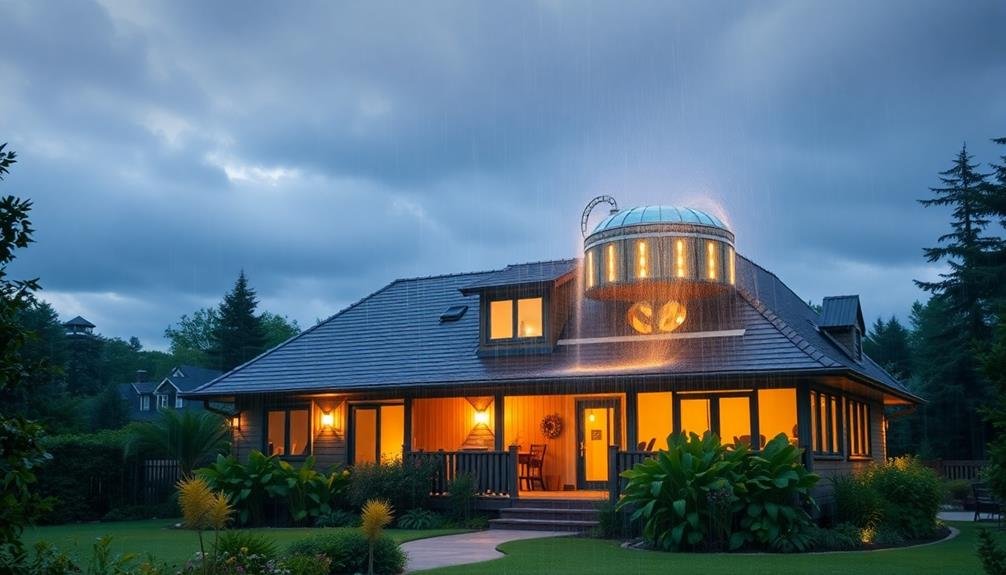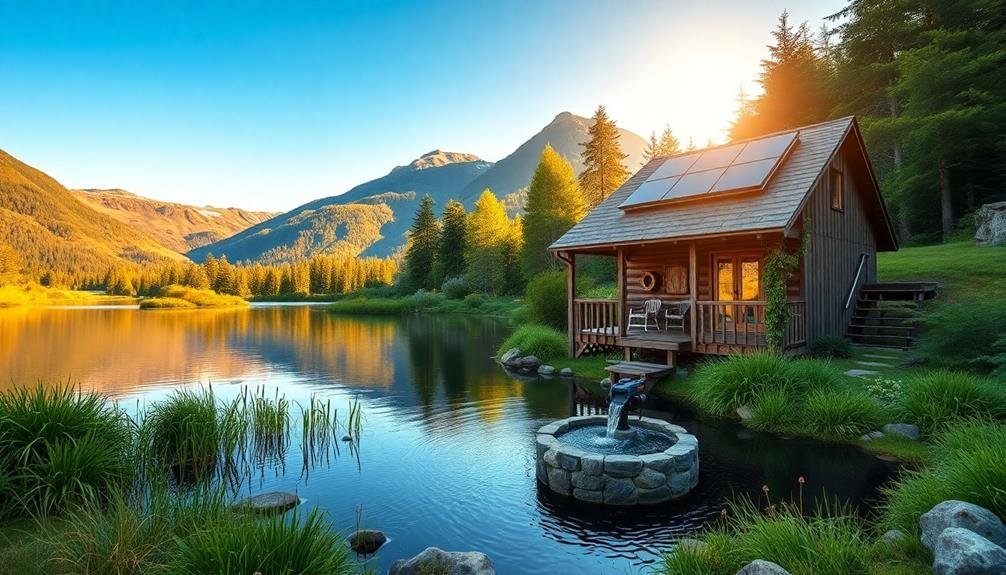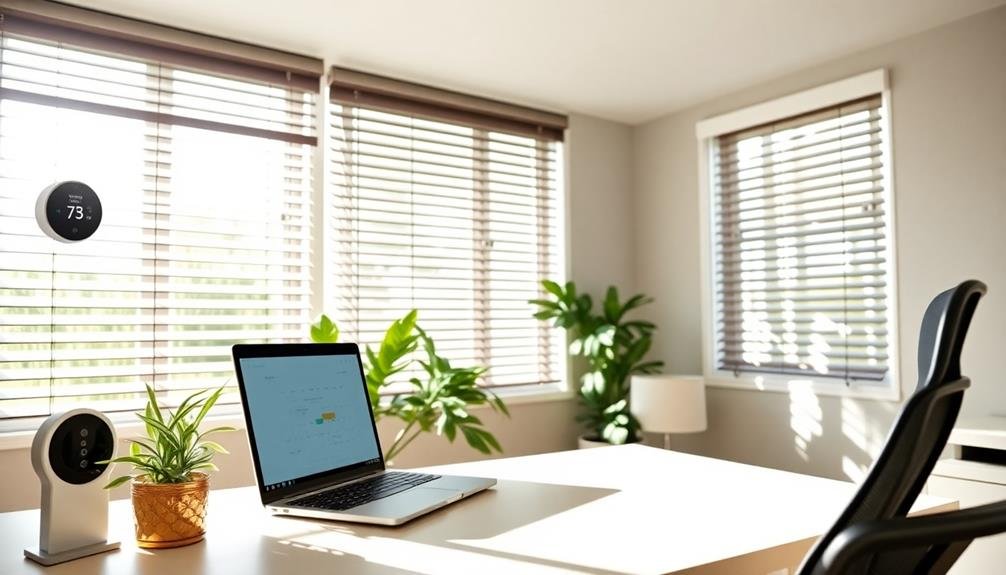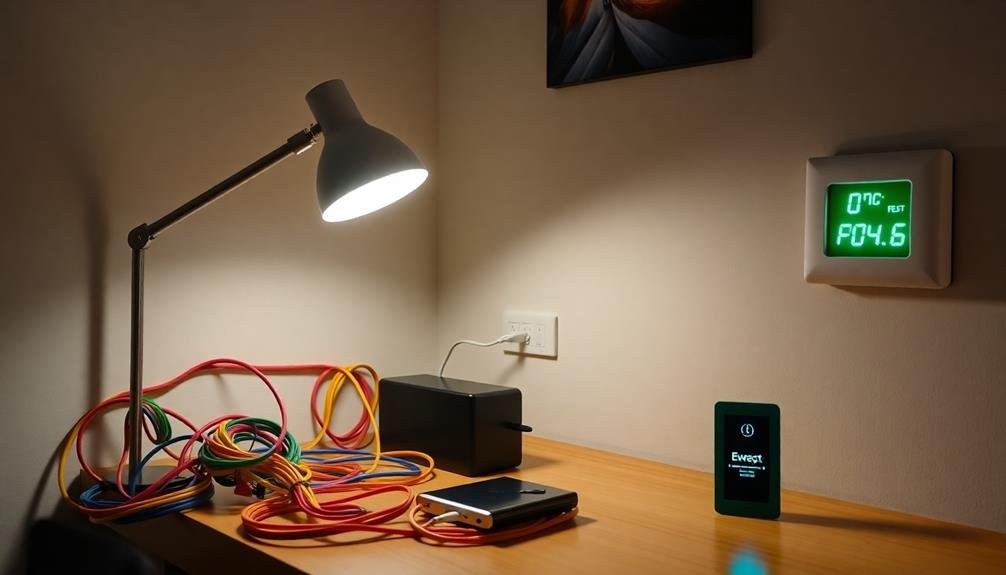Discover how micro-hydro power transforms homes across diverse settings. You'll find a remote cabin harnessing mountain streams, suburban homes tapping urban creeks, and backyard waterfalls generating electricity. Farms double their output with innovative irrigation systems, while coastal homes light up using tidal flows. Rainwater harvesting meets power needs in some areas, and alpine chalets run on snowmelt runoff. Spring-fed ponds support off-grid living, and river rapids empower entire riverside communities. These success stories showcase the potential of small-scale hydroelectric systems to revolutionize residential energy. Explore further to uncover the full potential of micro-hydro power in your own backyard.
Mountain Stream Powers Remote Cabin

Nestled deep in the Cascade Mountains, John and Sarah Miller's off-grid cabin harnesses the power of a nearby stream to generate electricity. The couple installed a micro-hydro system that captures the energy from the fast-flowing water, providing a consistent and renewable power source for their remote home.
You'll find their setup ingeniously simple yet effective. A small dam diverts water into a pipe, which runs downhill to a turbine housed in a weatherproof shed. As the water spins the turbine, it generates electricity that's stored in batteries for use day and night.
This system produces enough power to run their lights, refrigerator, and other essential appliances. It's even capable of handling occasional high-demand items like power tools.
You'll be impressed by how the Millers have achieved energy independence while minimizing their environmental impact.
Their success story demonstrates that with the right location and resources, you can create a sustainable power solution for off-grid living. The Millers' experience proves that micro-hydro power can be a reliable and eco-friendly alternative to traditional energy sources in suitable environments.
Urban Creek Energizes Suburban Home
In the heart of a bustling suburb, the Johnson family has turned their backyard creek into a powerhouse. Their small-scale hydro system harnesses the flow of a modest urban stream, generating enough electricity to cover 60% of their household needs.
You'll be impressed by their innovative setup. A carefully designed intake system diverts a portion of the creek's flow without disrupting local ecosystems. The water travels through a buried penstock to a compact turbine housed in a soundproof shed.
This ingenious design minimizes visual impact and noise, keeping neighbors happy and property values stable.
The Johnsons' system produces clean energy 24/7, unlike solar panels that only work during daylight hours. They've installed a battery bank to store excess power for use during peak demand times. On particularly productive days, they even sell surplus electricity back to the grid.
You'll appreciate how this project showcases the untapped potential in urban waterways. It's a demonstration of how creative thinking can turn overlooked resources into valuable assets.
The Johnsons' success has inspired other homeowners in their community to explore micro-hydro possibilities, sparking a mini-revolution in suburban energy production.
Backyard Waterfall Generates Electricity

You'll be amazed at how a backyard waterfall can power your home with the right turbine design.
Efficient micro-hydro systems can generate substantial electricity even from modest water flows.
While permit challenges may seem intimidating at first, many homeowners have successfully navigated the process to harness their property's natural water features.
Efficient Turbine Design
A backyard waterfall can be more than just a beautiful landscaping feature; it can also generate electricity with the right turbine design. Efficient turbines are essential for maximizing power output from small-scale water sources. You'll want to choose a turbine that's well-suited to your specific water flow and head height.
For residential micro-hydro systems, three popular turbine types stand out:
- Pelton wheels: Ideal for high head, low flow situations
- Cross-flow turbines: Versatile and suitable for a wide range of conditions
- Propeller turbines: Best for low head, high flow scenarios
When selecting a turbine, consider factors like efficiency, durability, and ease of maintenance. Look for designs that minimize friction and energy loss.
Modern materials and manufacturing techniques have led to significant improvements in turbine efficiency, even for small-scale applications.
You can further optimize your system by incorporating adjustable guide vanes or variable pitch blades. These features allow the turbine to adapt to changing water conditions, maintaining high efficiency across different flow rates.
Overcoming Permit Challenges
Maneuvering the permit process for a backyard micro-hydro system can often be challenging. You'll need to navigate local regulations, environmental concerns, and water rights issues. However, many homeowners have successfully overcome these hurdles, turning their backyard waterfalls into eco-friendly power sources.
To streamline your permit process, consider these key steps:
| Step | Action |
|---|---|
| 1 | Research local zoning laws |
| 2 | Contact your water authority |
| 3 | Prepare detailed system plans |
| 4 | Address environmental impacts |
| 5 | Seek professional assistance |
Start by thoroughly researching your local zoning laws and building codes. You'll need to understand any restrictions on water use and power generation. Next, contact your local water authority to discuss water rights and usage permits. Prepare detailed plans of your proposed system, including its impact on water flow and aquatic life. Be ready to address any environmental concerns raised by regulators. If you're facing complex challenges, don't hesitate to seek help from experienced micro-hydro consultants or lawyers familiar with renewable energy projects. With persistence and proper planning, you can overcome permit hurdles and harness the power of your backyard waterfall.
Farm Irrigation System Doubles Output
John Anderson's small dairy farm in upstate New York underwent a remarkable transformation after installing a micro-hydro system. By harnessing the power of a nearby stream, he not only reduced his electricity costs but also doubled his farm's irrigation capacity.
You'll be amazed at how this system revolutionized Anderson's farm operations:
- Increased water flow: The micro-hydro turbine pumped water more efficiently, allowing for expanded crop irrigation.
- Energy independence: The system generated enough electricity to power the farm's daily operations, reducing reliance on the grid.
- Cost savings: Anderson's utility bills dropped by 70%, freeing up funds for other farm improvements.
The success of Anderson's project inspired neighboring farms to explore micro-hydro options. You can learn from his experience by evaluating your property's water resources and consulting with local experts.
Remember, even small streams can generate significant power. With proper planning and implementation, you could transform your farm's productivity while reducing its environmental impact.
Don't underestimate the potential of micro-hydro – it might be the key to releasing your farm's full potential.
Coastal Tidal Flow Lights Beachfront

You'll be impressed by the innovative tidal turbine system design that harnesses coastal energy for beachfront lighting.
The energy generation statistics reveal a surprising efficiency, with the system producing enough power to illuminate a mile-long stretch of shoreline.
An environmental impact assessment shows minimal disruption to marine life, making this a sustainable solution for coastal communities.
Tidal Turbine System Design
Coastal tidal flows offer a unique opportunity for beachfront properties to harness renewable energy. You can design a tidal turbine system that captures the power of ocean currents to generate electricity for your home. These systems consist of underwater turbines anchored to the seabed, connected to generators that convert mechanical energy into electrical power.
When designing your tidal turbine system, consider these key factors:
- Site assessment: Evaluate water depth, tidal range, and current speeds to determine the ideal location for your turbines.
- Turbine selection: Choose between horizontal or vertical axis turbines based on local conditions and energy requirements.
- Environmental impact: Assess potential effects on marine life and implement mitigation measures to protect ecosystems.
You'll need to work with marine engineers and local authorities to guarantee your system meets safety and environmental regulations.
The turbines are typically installed in water depths of 20-30 meters, with multiple units arranged in arrays to maximize energy capture. Your system should include a power conditioning unit to convert the variable AC output to grid-compatible electricity.
With proper design and maintenance, your tidal turbine system can provide a reliable, clean energy source for your beachfront property.
Energy Generation Statistics
Generating accurate energy statistics for coastal tidal flow systems can help you assess their potential for powering beachfront properties.
You'll want to evaluate factors like tidal range, flow velocity, and turbine efficiency to estimate power output. Typically, a well-designed residential tidal turbine can generate 1-5 kW of power, depending on local conditions.
To calculate your potential energy production, you'll need to measure tidal flow speeds at different times of day. You can expect higher outputs during spring tides and lower outputs during neap tides.
On average, a 3 kW turbine might produce 20-30 kWh per day, enough to power essential appliances in a small beachfront home.
It's important to track your system's performance over time. You'll likely see seasonal variations, with higher outputs during storms or strong currents.
Keep in mind that tidal energy is predictable but intermittent, so you'll need battery storage or grid connection for consistent power.
Environmental Impact Assessment
When evaluating the environmental impact of coastal tidal flow systems for beachfront properties, it's crucial to look into both positive and negative effects. These systems harness the power of tidal currents to generate electricity, providing a renewable energy source for coastal homes.
You'll find that they generally have a lower environmental footprint compared to traditional power sources, but there are still considerations to keep in mind.
Let's examine the key environmental impacts:
- Marine life disruption: Tidal turbines may affect fish migration patterns and pose risks to marine mammals. You'll need to assess potential impacts on local ecosystems.
- Sediment transport: The presence of tidal flow structures can alter natural sediment movement, potentially affecting beach erosion and accretion processes.
- Visual impact: While often submerged, some components may be visible, impacting the aesthetic value of the coastline.
You'll want to work closely with environmental experts to conduct thorough assessments and develop mitigation strategies.
Restored Mill Wheel Electrifies Village
Nestled in the heart of rural England, a picturesque village has breathed new life into its centuries-old mill wheel. This once-dormant structure now serves as a beacon of sustainable energy, powering homes and businesses throughout the community.
You'll find that the restoration project began when local residents recognized the untapped potential of their historic watermill. They've transformed it into a micro-hydro power plant, harnessing the steady flow of the nearby river. The refurbished wheel, crafted from durable materials, now generates clean electricity 24/7.
What's remarkable is how this initiative has united the village. You'll see that residents have embraced their role in maintaining and operating the system. They've even established an energy cooperative, ensuring fair distribution and management of the generated power.
The success of this project hasn't gone unnoticed. You'll discover that neighboring communities are now exploring similar opportunities, inspired by the village's ingenuity.
This restored mill wheel isn't just electrifying a village; it's sparking a movement towards localized, sustainable power generation across the region.
Rainwater Harvesting Meets Power Needs

In the domain of innovative micro-hydro solutions, rainwater harvesting has emerged as a powerful ally.
You'll find that combining rainwater collection systems with micro-hydro turbines can provide a sustainable energy source for your home. This approach harnesses the power of gravity and rainfall to generate electricity, even in areas without natural streams or rivers.
To implement this system, you'll need:
- A large rainwater collection tank
- A micro-hydro turbine
- A pipeline connecting the tank to the turbine
You'll place the collection tank at a higher elevation than your home, allowing water to flow downhill through the pipeline. As the water passes through the turbine, it generates electricity for your household needs.
The beauty of this system lies in its simplicity and efficiency.
You'll find that rainwater harvesting for micro-hydro power works best in regions with consistent rainfall. However, even in areas with seasonal precipitation, you can store water during wet periods for use during drier times.
This approach not only provides clean energy but also promotes water conservation and reduces your reliance on the grid.
Snowmelt Runoff Fuels Alpine Chalet
You'll find an inspiring example of year-round energy generation at a remote alpine chalet nestled high in the mountains.
This eco-friendly mountain dwelling harnesses the power of snowmelt runoff to produce clean electricity throughout the year.
Year-Round Energy Generation
High in the Swiss Alps, a charming chalet takes advantage of nature's continuous water cycle. The owners have installed a micro-hydro system that harnesses the power of snowmelt runoff, providing a sustainable energy source year-round.
You'll be amazed at how this simple yet ingenious setup keeps the lights on and appliances running, even in the harshest winter conditions.
The system's year-round energy generation is made possible by:
- Continuous water flow from melting snow and glaciers
- A cleverly designed intake system that prevents freezing
- Efficient turbines that operate in varying water volumes
You'll find that this alpine chalet isn't just relying on sunny days or windy conditions for power. Instead, it's tapping into a constant, renewable resource that's readily available in its mountainous location.
The micro-hydro system adapts to seasonal changes, producing more energy during peak snowmelt periods and maintaining a steady output during drier months. This reliable power source guarantees the chalet remains comfortable and functional throughout the year, showcasing the potential of residential micro-hydro power in areas with suitable water resources.
Eco-Friendly Mountain Living
Nestled among snow-capped peaks, the alpine chalet demonstrates how eco-friendly mountain living can be both comfortable and sustainable.
You'll find this picturesque retreat harnessing the power of snowmelt runoff through a cleverly designed micro-hydro system. As winter's blanket melts away, the resulting streams cascade down the mountainside, providing a consistent energy source for the chalet.
The owners have integrated a small turbine into the natural water flow, generating clean electricity without disrupting the local ecosystem. You'll notice how seamlessly the system blends with the surrounding landscape, preserving the area's natural beauty.
Inside, you're greeted by modern amenities powered entirely by this renewable energy source.
During peak snowmelt seasons, excess energy is stored in batteries for use during drier periods. This guarantees year-round power availability, even when water flow diminishes.
The chalet's design also incorporates other eco-friendly features like solar thermal panels for hot water and high-efficiency insulation to minimize energy consumption.
Spring-Fed Pond Supports Off-Grid Living

Harnessing the power of a natural spring, the Johnson family transformed their remote property into a self-sustaining oasis. Their spring-fed pond not only provides a serene backdrop but also serves as the cornerstone of their off-grid living system.
By installing a micro-hydro turbine at the pond's outflow, they've created a reliable source of clean energy that powers their entire homestead.
You'll be amazed at how this simple yet ingenious setup works:
- The spring continuously replenishes the pond, ensuring a constant water flow.
- Water from the pond is channeled through a pipeline to the turbine.
- The turbine converts the water's kinetic energy into electricity, which is stored in batteries for later use.
This system generates enough power to run their energy-efficient appliances, lighting, and even a small workshop.
The Johnsons have embraced a sustainable lifestyle, reducing their carbon footprint while enjoying the comforts of modern living.
They've proven that with careful planning and the right resources, you can create an eco-friendly home that's both self-sufficient and comfortable, even in remote locations.
River Rapids Empower Riverside Community
Along the banks of the rushing Clearwater River, a small community has tapped into the power of nature to revolutionize their energy supply.
You'll find a network of micro-hydro turbines strategically placed in the river's rapids, generating clean electricity for over 50 homes.
The project began when residents sought an alternative to expensive grid connections. They've installed a series of low-impact, run-of-river systems that don't require dams or large reservoirs. Each turbine harnesses the river's kinetic energy, converting it into usable power for the community.
You'll notice how the turbines blend seamlessly with the natural environment, minimizing disruption to local ecosystems. The community's energy cooperative manages the system, ensuring fair distribution and maintenance.
This innovative approach has slashed electricity bills by 70% and eliminated power outages. It's also fostered a sense of self-reliance and environmental stewardship among residents.
You can see solar panels complementing the hydro system on many rooftops, creating a robust, diversified energy network.
The Clearwater community's success has inspired neighboring towns to explore similar micro-hydro solutions, sparking a regional shift towards sustainable, locally-produced energy.
Frequently Asked Questions
What Permits Are Required for Installing a Residential Micro-Hydro Power System?
You'll likely need water rights, environmental, and construction permits from local, state, and federal agencies. Check with your county's planning department, state's water resources board, and the Federal Energy Regulatory Commission for specific requirements.
How Much Does a Typical Micro-Hydro System Cost to Install?
You'll find micro-hydro system costs vary widely. Typically, you're looking at $1,000 to $20,000 for installation. Factors like site conditions, power output, and equipment quality will influence your final price. It's best to get personalized quotes.
Can Micro-Hydro Power Be Combined With Other Renewable Energy Sources?
Yes, you can combine micro-hydro power with other renewable sources. You'll often see it paired with solar panels or wind turbines. This hybrid approach can provide more consistent energy and help overcome limitations of individual systems.
What Maintenance Is Required for a Residential Micro-Hydro Power System?
You'll need to regularly clean debris from intakes, inspect and lubricate moving parts, and check for wear on turbine components. It's also important to monitor water levels, electrical connections, and generator performance. Annual professional inspections are recommended.
How Long Do Micro-Hydro Turbines Typically Last Before Needing Replacement?
You'll find micro-hydro turbines are quite durable. With proper maintenance, they can last 20-30 years before needing replacement. However, you'll need to replace bearings and seals more frequently, typically every 5-10 years, to guarantee peak performance.
In Summary
You've seen how micro-hydro power can transform homes and communities. Whether it's a mountain stream, urban creek, or coastal tides, there's potential for clean energy all around you. Don't underestimate the power of water on your property. With creativity and the right technology, you can harness nature's flow to reduce your carbon footprint and energy bills. Embrace the possibilities of micro-hydro power and join the growing movement towards sustainable, self-sufficient living.





Leave a Reply